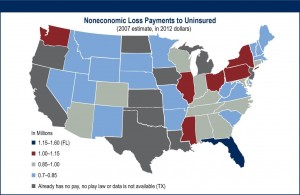A state’s percentage of uninsured motorists is affected by a no pay, no play law, albeit modestly.
A new study from the Insurance Research Council (IRC) estimates that the uninsured motorist (UM) rate can fall by as much as 1.6 percent after a state adopts a no pay, no play law.
No pay, no play laws limit the compensation for people who were breaking the law when they were injured in a car accident. Breaking the law includes driving without insurance and, in some states, driving while intoxicated.
Currently, 10 states have no pay, no play laws on the books: Alaska, California, Iowa, Kansas, Louisiana, Michigan, New Jersey, North Dakota, Oklahoma and Oregon.
In the study, The Potential Effects of No Pay, No Play Laws, IRC provides a background on each existing state law.
For states without a no pay, no play law in effect, IRC developed a mathematical model to estimate the compensation for non-economic loss paid to uninsured third-party liability claimants in a given year. IRC says this estimate provides a reasonable upper limit proxy for the amount of money that is currently awarded to the uninsured population and would no longer be paid if a state implemented a strict no pay, no play law.
Across all of the 39 states studied using 2007 data, the average non-economic loss paid to uninsured claimants per state was $17.5 million. These findings suggest the average insured driver in 2007 paid an additional $4.69 ($5.10 in 2012 dollars) to address the average $17.5 million in non-economic loss ($19.3 million on average in 2012 dollars) that was awarded to uni
nsured claimants in
each state.
“The original intent of these laws was to relieve at-fault drivers who comply with state insurance requirements from having to compensate uninsured drivers for non-economic damages. Yet, little research had been conducted analyzing the effect of
no pay, no play laws on the overall insurance market,” said Elizabeth Sprinkel, senior vice president of IRC. “With this study, we now have more information on how these laws affect the population of motorists driving uninsured. This report, which also develops cost estimates for states that do not have no pay, no play laws on the books, highlights the benefits a strict law may provide to the average insured consumer.”
Was this article valuable?
Here are more articles you may enjoy.




 Nearly Half of 100 Largest P/C Insurers Destroy Value: ACORD
Nearly Half of 100 Largest P/C Insurers Destroy Value: ACORD  MAPFRE Accuses AAA of Violating Long-Time Exclusive Marketing Agreement
MAPFRE Accuses AAA of Violating Long-Time Exclusive Marketing Agreement  Georgia Republicans Move to Scrap State Income Tax by 2032 Despite Concerns
Georgia Republicans Move to Scrap State Income Tax by 2032 Despite Concerns  Supreme Court Rejects Challenge to $2.46B Boy Scouts Sex Abuse Settlement
Supreme Court Rejects Challenge to $2.46B Boy Scouts Sex Abuse Settlement 

